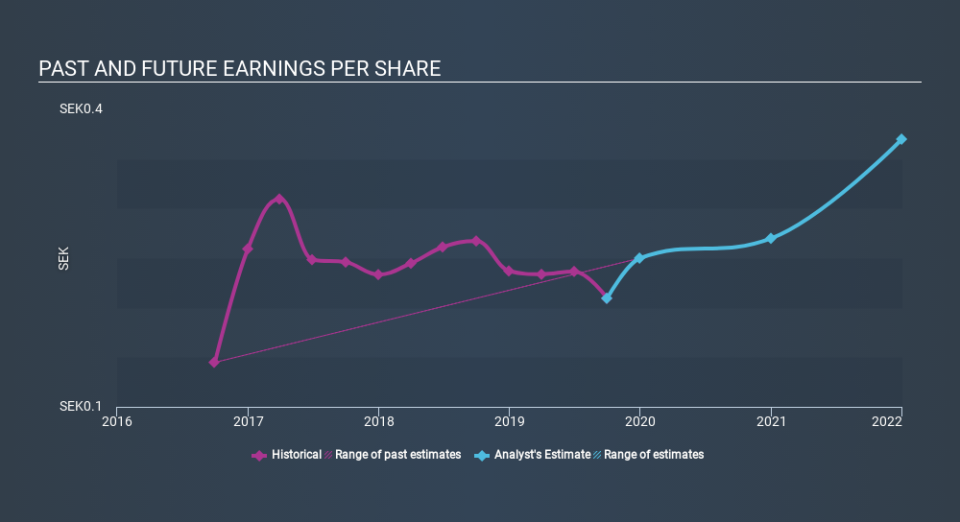Did Business Growth Power Feelgood Svenska's (STO:FEEL) Share Price Gain of 153%?

When you buy shares in a company, it's worth keeping in mind the possibility that it could fail, and you could lose your money. But on the bright side, if you buy shares in a high quality company at the right price, you can gain well over 100%. For example, the Feelgood Svenska AB (publ) (STO:FEEL) share price has soared 153% in the last half decade. Most would be very happy with that. Unfortunately, though, the stock has dropped 6.9% over a week. However, this might be related to the overall market decline of 1.0% in a week.
See our latest analysis for Feelgood Svenska
While markets are a powerful pricing mechanism, share prices reflect investor sentiment, not just underlying business performance. By comparing earnings per share (EPS) and share price changes over time, we can get a feel for how investor attitudes to a company have morphed over time.
During the last half decade, Feelgood Svenska became profitable. That kind of transition can be an inflection point that justifies a strong share price gain, just as we have seen here. Given that the company made a profit three years ago, but not five years ago, it is worth looking at the share price returns over the last three years, too. We can see that the Feelgood Svenska share price is up 6.0% in the last three years. In the same period, EPS is up 13% per year. This EPS growth is higher than the 2.0% average annual increase in the share price over the same three years. So you might conclude the market is a little more cautious about the stock, these days.
You can see below how EPS has changed over time (discover the exact values by clicking on the image).
Dive deeper into Feelgood Svenska's key metrics by checking this interactive graph of Feelgood Svenska's earnings, revenue and cash flow.
What About Dividends?
It is important to consider the total shareholder return, as well as the share price return, for any given stock. The TSR is a return calculation that accounts for the value of cash dividends (assuming that any dividend received was reinvested) and the calculated value of any discounted capital raisings and spin-offs. Arguably, the TSR gives a more comprehensive picture of the return generated by a stock. As it happens, Feelgood Svenska's TSR for the last 5 years was 172%, which exceeds the share price return mentioned earlier. This is largely a result of its dividend payments!
A Different Perspective
While the broader market gained around 29% in the last year, Feelgood Svenska shareholders lost 1.4% (even including dividends) . Even the share prices of good stocks drop sometimes, but we want to see improvements in the fundamental metrics of a business, before getting too interested. On the bright side, long term shareholders have made money, with a gain of 22% per year over half a decade. If the fundamental data continues to indicate long term sustainable growth, the current sell-off could be an opportunity worth considering. While it is well worth considering the different impacts that market conditions can have on the share price, there are other factors that are even more important. For instance, we've identified 2 warning signs for Feelgood Svenska that you should be aware of.
We will like Feelgood Svenska better if we see some big insider buys. While we wait, check out this free list of growing companies with considerable, recent, insider buying.
Please note, the market returns quoted in this article reflect the market weighted average returns of stocks that currently trade on SE exchanges.
If you spot an error that warrants correction, please contact the editor at editorial-team@simplywallst.com. This article by Simply Wall St is general in nature. It does not constitute a recommendation to buy or sell any stock, and does not take account of your objectives, or your financial situation. Simply Wall St has no position in the stocks mentioned.
We aim to bring you long-term focused research analysis driven by fundamental data. Note that our analysis may not factor in the latest price-sensitive company announcements or qualitative material. Thank you for reading.



